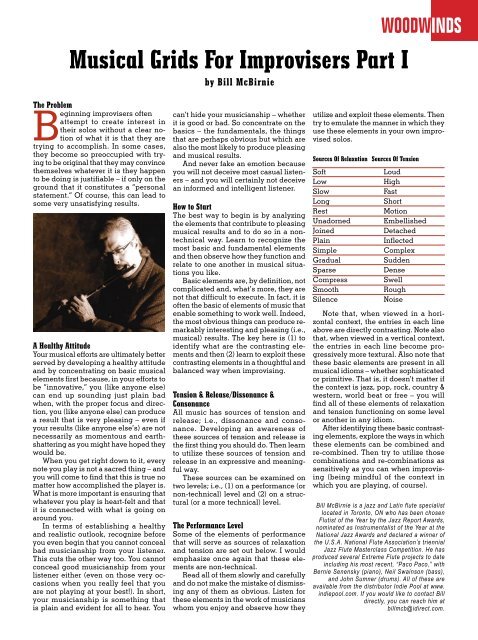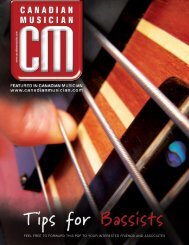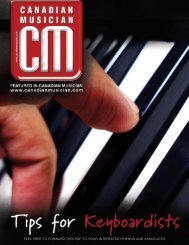Download (PDF) - Canadian Musician
Download (PDF) - Canadian Musician
Download (PDF) - Canadian Musician
You also want an ePaper? Increase the reach of your titles
YUMPU automatically turns print PDFs into web optimized ePapers that Google loves.
Musical Grids For Improvisers Part I<br />
by Bill McBirnie<br />
woodwinds<br />
The Problem<br />
Beginning improvisers often<br />
attempt to create interest in<br />
their solos without a clear notion<br />
of what it is that they are<br />
trying to accomplish. In some cases,<br />
they become so preoccupied with trying<br />
to be original that they may convince<br />
themselves whatever it is they happen<br />
to be doing is justifiable – if only on the<br />
ground that it constitutes a “personal<br />
statement.” Of course, this can lead to<br />
some very unsatisfying results.<br />
A Healthy Attitude<br />
Your musical efforts are ultimately better<br />
served by developing a healthy attitude<br />
and by concentrating on basic musical<br />
elements first because, in your efforts to<br />
be “innovative,” you (like anyone else)<br />
can end up sounding just plain bad<br />
when, with the proper focus and direction,<br />
you (like anyone else) can produce<br />
a result that is very pleasing – even if<br />
your results (like anyone else’s) are not<br />
necessarily as momentous and earthshattering<br />
as you might have hoped they<br />
would be.<br />
When you get right down to it, every<br />
note you play is not a sacred thing – and<br />
you will come to find that this is true no<br />
matter how accomplished the player is.<br />
What is more important is ensuring that<br />
whatever you play is heart-felt and that<br />
it is connected with what is going on<br />
around you.<br />
In terms of establishing a healthy<br />
and realistic outlook, recognize before<br />
you even begin that you cannot conceal<br />
bad musicianship from your listener.<br />
This cuts the other way too. You cannot<br />
conceal good musicianship from your<br />
listener either (even on those very occasions<br />
when you really feel that you<br />
are not playing at your best!). In short,<br />
your musicianship is something that<br />
is plain and evident for all to hear. You<br />
can’t hide your musicianship – whether<br />
it is good or bad. So concentrate on the<br />
basics – the fundamentals, the things<br />
that are perhaps obvious but which are<br />
also the most likely to produce pleasing<br />
and musical results.<br />
And never fake an emotion because<br />
you will not deceive most casual listeners<br />
– and you will certainly not deceive<br />
an informed and intelligent listener.<br />
How to Start<br />
The best way to begin is by analyzing<br />
the elements that contribute to pleasing<br />
musical results and to do so in a nontechnical<br />
way. Learn to recognize the<br />
most basic and fundamental elements<br />
and then observe how they function and<br />
relate to one another in musical situations<br />
you like.<br />
Basic elements are, by definition, not<br />
complicated and, what’s more, they are<br />
not that difficult to execute. In fact, it is<br />
often the basic of elements of music that<br />
enable something to work well. Indeed,<br />
the most obvious things can produce remarkably<br />
interesting and pleasing (i.e.,<br />
musical) results. The key here is (1) to<br />
identify what are the contrasting elements<br />
and then (2) learn to exploit these<br />
contrasting elements in a thoughtful and<br />
balanced way when improvising.<br />
Tension & Release/Dissonance &<br />
Consonance<br />
All music has sources of tension and<br />
release; i.e., dissonance and consonance.<br />
Developing an awareness of<br />
these sources of tension and release is<br />
the first thing you should do. Then learn<br />
to utilize these sources of tension and<br />
release in an expressive and meaningful<br />
way.<br />
These sources can be examined on<br />
two levels; i.e., (1) on a performance (or<br />
non-technical) level and (2) on a structural<br />
(or a more technical) level.<br />
The Performance Level<br />
Some of the elements of performance<br />
that will serve as sources of relaxation<br />
and tension are set out below. I would<br />
emphasize once again that these elements<br />
are non-technical.<br />
Read all of them slowly and carefully<br />
and do not make the mistake of dismissing<br />
any of them as obvious. Listen for<br />
these elements in the work of musicians<br />
whom you enjoy and observe how they<br />
utilize and exploit these elements. Then<br />
try to emulate the manner in which they<br />
use these elements in your own improvised<br />
solos.<br />
Sources Of Relaxation Sources Of Tension<br />
Soft<br />
Loud<br />
Low<br />
High<br />
Slow<br />
Fast<br />
Long<br />
Short<br />
Rest<br />
Motion<br />
Unadorned Embellished<br />
Joined<br />
Detached<br />
Plain<br />
Inflected<br />
Simple<br />
Complex<br />
Gradual<br />
Sudden<br />
Sparse<br />
Dense<br />
Compress Swell<br />
Smooth<br />
Rough<br />
Silence<br />
Noise<br />
Note that, when viewed in a horizontal<br />
context, the entries in each line<br />
above are directly contrasting. Note also<br />
that, when viewed in a vertical context,<br />
the entries in each line become progressively<br />
more textural. Also note that<br />
these basic elements are present in all<br />
musical idioms – whether sophisticated<br />
or primitive. That is, it doesn’t matter if<br />
the context is jazz, pop, rock, country &<br />
western, world beat or free – you will<br />
find all of these elements of relaxation<br />
and tension functioning on some level<br />
or another in any idiom.<br />
After identifying these basic contrasting<br />
elements, explore the ways in which<br />
these elements can be combined and<br />
re-combined. Then try to utilize those<br />
combinations and re-combinations as<br />
sensitively as you can when improvising<br />
(being mindful of the context in<br />
which you are playing, of course).<br />
Bill McBirnie is a jazz and Latin flute specialist<br />
located in Toronto, ON who has been chosen<br />
Flutist of the Year by the Jazz Report Awards,<br />
nominated as Instrumentalist of the Year at the<br />
National Jazz Awards and declared a winner of<br />
the U.S.A. National Flute Association’s triennial<br />
Jazz Flute Masterclass Competition. He has<br />
produced several Extreme Flute projects to date<br />
including his most recent, “Paco Paco,” with<br />
Bernie Senensky (piano), Neil Swainson (bass),<br />
and John Sumner (drums). All of these are<br />
available from the distributor Indie Pool at www.<br />
indiepool.com. If you would like to contact Bill<br />
directly, you can reach him at<br />
billmcb@idirect.com.





